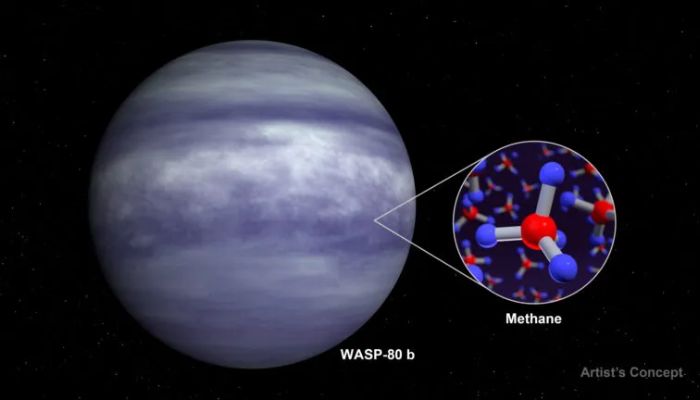
A remarkable discovery has been made by the James Webb Space Telescope (JWST), published in the journal Nature, detecting the presence of methane and water vapour within the atmosphere of a Jupiter-like exoplanet situated approximately 163 light-years away.
A team of astronomers employed this cutting-edge infrared space telescope to observe the extra-solar planet, known as WASP-80 b, as it transited in front of its host red dwarf star. Orbiting its star approximately every three Earth days, WASP-80 b's passage provided an opportune moment for this groundbreaking observation.
While water vapour has been previously spotted in the atmospheres of about a dozen planets, the identification of methane — commonly found in our solar system's gas giants such as Jupiter, Saturn, Uranus, and Neptune — using space-based spectroscopy has been comparatively rare. Arizona State University scientists Luis Welbanks and Michael Line from the School of Earth and Space Exploration, alongside Bay Area Environmental Research Institute (BAERI) researcher Taylor Bell, were part of the team that leveraged the JWST to accomplish this feat.
Read more: Mars missions on hold: What drove NASA to suspend operations?
Although this isn't the JWST's maiden detection of atmospheric methane — an example being the observation of similar molecules around exoplanet K12-18b earlier this year — the recent findings regarding WASP-80 b further enhance our understanding of distant planetary atmospheres.
WASP-80 b, termed a "warm Jupiter" due to its intermediate proximity to its parent star, presents a challenge to astronomers akin to finding a needle in a cosmic haystack. Detecting and distinguishing it from the red dwarf star it orbits is comparable to locating a single human hair from a distance of 9 miles (14.5 kilometres).
Employing the transit method, astronomers observed the dimming of starlight caused by the planet's passage in front of its star. This allowed them to analyse a collective spectrum associated with the planet, uncovering distinctive fingerprints of specific molecules within its atmosphere.
Furthermore, the team utilised another method — measuring the planet's emitted infrared light before and after its eclipse of the star. By analysing these "eclipse spectra," astronomers identified light absorption patterns revealing molecules present in the exoplanet's atmosphere.
Combining transit and eclipse data enabled scientists to ascertain the quantities of light absorbed and emitted by WASP-80 b's atmosphere at various wavelengths. This comprehensive approach led to the conclusive detection of methane within the exoplanet's atmosphere.
The newfound knowledge will aid researchers in comprehending WASP-80 b's characteristics, formation history, and evolution, based on methane and water abundances. This exploration is crucial in unravelling the mysteries of distant worlds and may provide insights into the potential presence of biology-indicative gases on exoplanets.
















